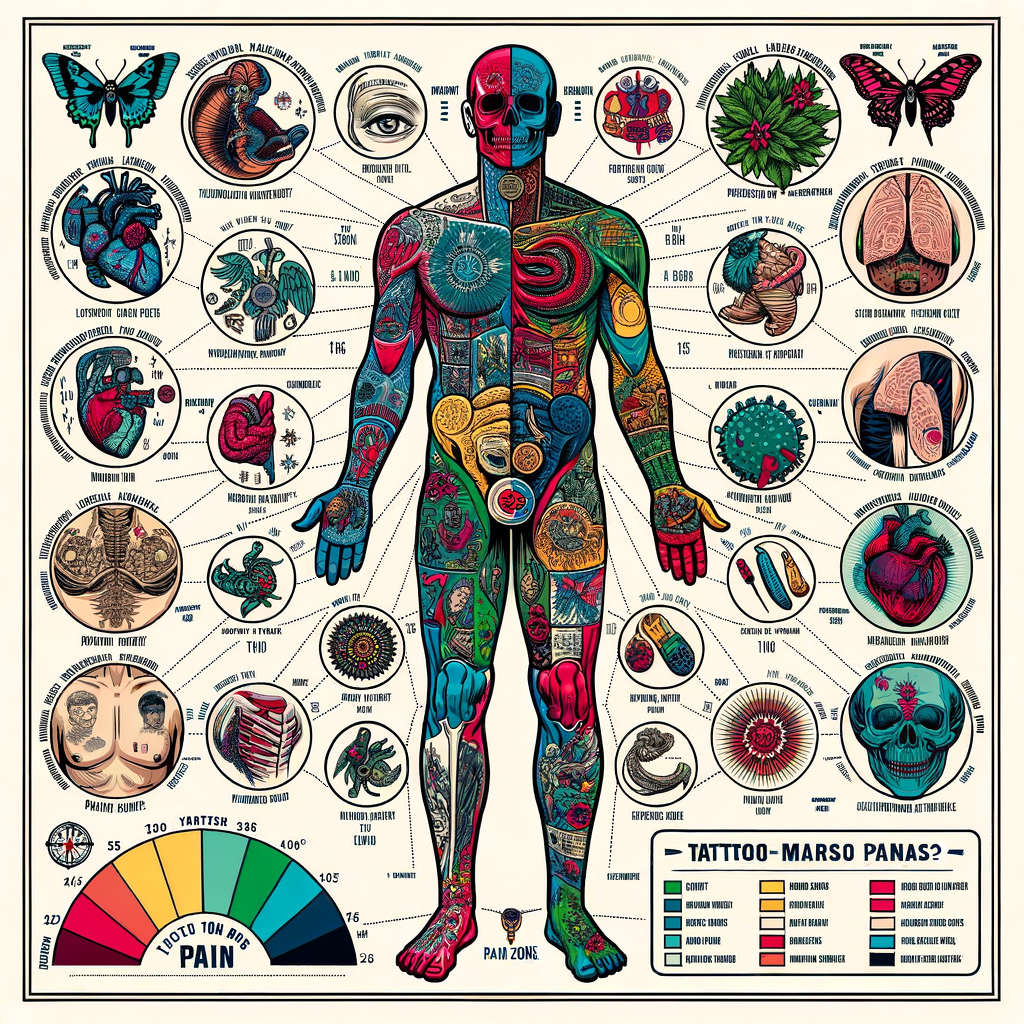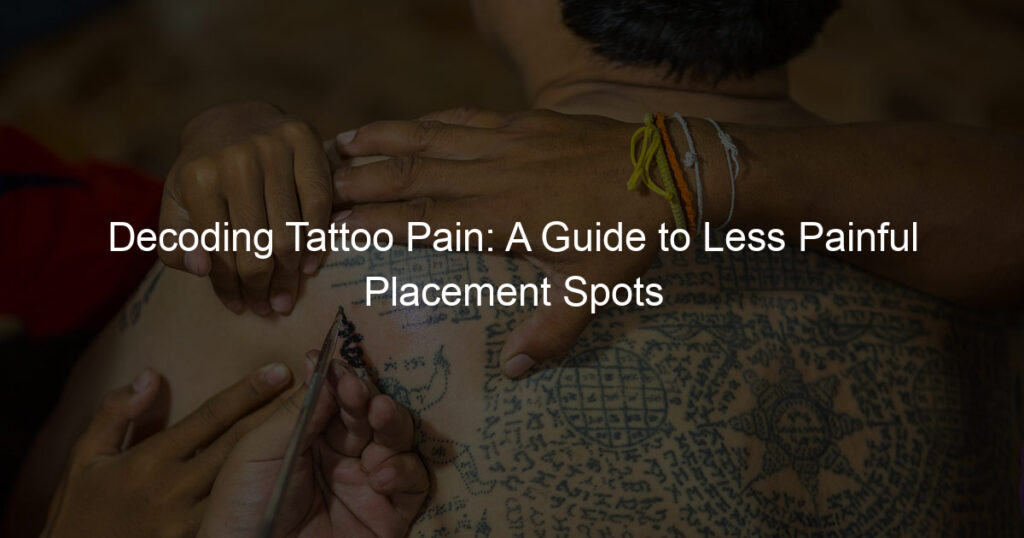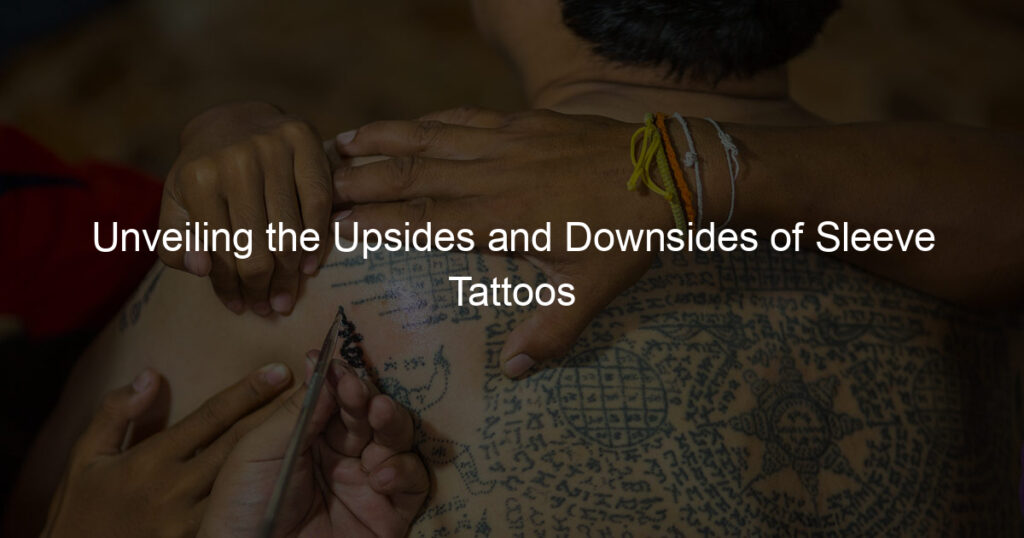
Introduction: Decoding Tattoo Pain
Have you ever wondered what it feels like to get a tattoo? The sensation of tattoo pain is a common concern for those considering their first tattoo. This introduction will help you understand the concept of tattoo pain and the factors that influence its intensity.
Tattoo pain is a unique sensation that varies from person to person. It’s not just about the physical feeling of the needle piercing the skin. It’s also about the emotional response to the experience. Some people describe it as a sharp sting, others as a dull ache, and some even find it pleasurable. But one thing is certain: tattoo pain is temporary, and it’s a small price to pay for a piece of art you’ll carry with you forever.
Several factors can influence how much pain you feel when getting a tattoo. These include the location of the tattoo, the size and complexity of the design, your personal pain threshold, and the skill of the tattoo artist. For example, areas with more nerve endings or closer to the bone tend to be more sensitive. Larger and more complex tattoos also take longer to complete, which can increase the discomfort. But remember, everyone’s experience is different, and what feels painful to one person might be a breeze for another.
In the following sections, we’ll delve deeper into these factors, providing a detailed tattoo pain guide, a tattoo pain chart, and tips for reducing tattoo pain. Whether you’re a tattoo newbie or a seasoned ink enthusiast, this information will help you make informed decisions about your next tattoo.
Tattoo Pain Guide: How Painful is Getting a Tattoo?
Getting a tattoo can be an exciting experience, but it’s also one that comes with its fair share of discomfort. The level of pain you might experience when getting a tattoo can depend on a variety of factors. Here, we’ll explore three key factors that can influence the level of pain you might feel when getting a tattoo: individual pain tolerance, the location of the tattoo, and the size and complexity of the tattoo.
-
- Individual Pain Tolerance
Everyone has a different threshold for pain. Some people might find the sensation of getting a tattoo to be mildly uncomfortable, while others might find it to be quite painful. It’s important to remember that what might be painful for one person might not be for another. This is why it’s essential to have a clear understanding of your own pain tolerance before deciding to get a tattoo.
-
- Location of the Tattoo
The location of the tattoo on your body can also significantly impact the level of pain you might experience. Some areas, like the ribs, feet, and hands, are known to be more painful due to the proximity of the bone to the skin. On the other hand, areas with more fat or muscle, like the arms or thighs, might be less painful to tattoo.
-
- Tattoo Size and Complexity
The size and complexity of the tattoo can also play a role in how painful the tattooing process might be. Larger tattoos that cover a significant area of the body or complex designs that require more detail can take longer to complete, which can result in more discomfort. On the other hand, smaller tattoos or simpler designs might be less painful due to the shorter tattooing process.
In conclusion, the pain experienced when getting a tattoo can vary greatly from person to person. It’s always a good idea to discuss any concerns about pain with your tattoo artist before the procedure, as they can provide advice and techniques to help manage any discomfort.
Tattoo Pain Chart: Mapping Painful Tattoo Locations
When it comes to getting a tattoo, one of the most common questions is, “How much will it hurt?” The answer isn’t straightforward because pain varies from person to person. However, certain areas of the body are generally more sensitive than others. Let’s explore the most and least painful spots to get a tattoo.
- Most painful tattoo spots
Some parts of the body are more sensitive due to a higher concentration of nerve endings or less fat padding. Here are the top five most painful spots to get a tattoo:
| Rank | Location |
|---|---|
| 1 | Ribs |
| 2 | Feet |
| 3 | Hands |
| 4 | Neck |
| 5 | Inner Elbow |
These areas are known to be painful because they are close to bones and have less fat to cushion the needle. The ribs, for example, are one of the most painful places to get a tattoo because the skin is thin and the bones are close to the surface.
- Least painful tattoo spots
On the other hand, some areas of the body are less sensitive and are considered the least painful places to get a tattoo. Here are the top five least painful spots:
| Rank | Location |
|---|---|
| 1 | Outer Shoulder |
| 2 | Outer Arm |
| 3 | Upper Back |
| 4 | Thigh |
| 5 | Calves |
These areas have more muscle and fat, providing a natural cushion that can help reduce the pain of getting a tattoo. For instance, the outer shoulder is often recommended for first-time tattoo recipients because it’s one of the least painful places to get inked.
Remember, everyone’s pain tolerance is different, and what might be painful for one person might not be for another. It’s always best to discuss your concerns with your tattoo artist before deciding on the location of your tattoo.
Where to Get a Tattoo: Tattoo Placement Ideas
Deciding where to get a tattoo can be as challenging as choosing the design itself. The location of your tattoo can say a lot about your personality and style. It’s also important to consider the level of visibility and pain you’re comfortable with. Let’s explore some popular tattoo locations that might inspire your next ink.
Best Places for Tattoos: Popular Tattoo Locations
When it comes to choosing a spot for your tattoo, there are several popular locations that people often opt for. These areas offer a good balance between visibility, ease of tattooing, and manageable pain levels. Here are three of the most popular tattoo locations:
- Forearm: The forearm is a popular location for tattoos due to its visibility and the relatively low pain level. It’s a great place for showcasing detailed designs. Plus, you can easily cover it up with a long-sleeved shirt if needed.
- Shoulder: Shoulder tattoos are trendy and versatile. They can be easily hidden or shown off depending on your outfit. The shoulder area also tends to be less sensitive, making the tattooing process more comfortable.
- Back: The back offers a large canvas for intricate designs or tattoos that require more space. It’s also one of the less painful areas to get tattooed. However, keep in mind that you won’t be able to see your tattoo without a mirror!
Remember, the best place for a tattoo is a personal choice. It should be a spot that you’re comfortable with and that suits the design you have in mind. Take your time to think about it and discuss your options with your tattoo artist. After all, a tattoo is a form of self-expression and should make you feel confident and happy.
Least Painful Tattoo Spots: Ideal for First-Timers
If you’re considering getting your first tattoo, it’s natural to feel a bit apprehensive about the pain. But don’t worry! There are certain areas on the body where getting a tattoo is generally less painful. Let’s explore some of these spots.
-
- Outer Bicep
The outer bicep is a great spot for a first tattoo. It’s not only a popular location due to its visibility, but it’s also one of the least painful places to get inked. The skin on the outer bicep is relatively thick and has fewer nerve endings compared to other parts of the body, which makes the tattooing process less painful.
-
- Thigh
Another ideal spot for first-timers is the thigh. The thigh has a good amount of fat and muscle, which can help cushion the impact of the tattoo needle. Plus, the skin on your thighs is less sensitive compared to other areas, making the tattooing process more bearable.
-
- Calves
Calves are also a good option for a less painful tattoo experience. Similar to the thigh, the calves have a good amount of muscle and fat, reducing the pain level. Additionally, the skin on the calves is less sensitive, which can make the tattooing process feel more like a mild discomfort rather than sharp pain.
Remember, everyone’s pain tolerance is different. What might be a breeze for one person could be more uncomfortable for another. It’s always a good idea to discuss your concerns about pain with your tattoo artist before getting inked. They can provide advice and techniques to help manage any discomfort.
Tattoo Placement and Pain: The Correlation
When it comes to getting a tattoo, one of the most common concerns is the pain involved. The level of discomfort you may experience during a tattoo session can vary greatly depending on several factors. In this section, we will delve into the correlation between tattoo placement and pain, focusing on the role of skin thickness and nerve endings, and how tattoo placement affects pain levels.
-
- Understanding the role of skin thickness and nerve endings
The human skin is not uniform in thickness across the body. Some areas, like the elbows and knees, have thicker skin, while others, like the inner arm or the back of the knee, have thinner skin. When getting a tattoo, the needle penetrates the skin to deposit ink. The thinner the skin, the closer the needle gets to the nerve endings, which can result in more pain.
Nerve endings are responsible for sending signals to the brain about sensations such as touch, temperature, and yes, pain. Areas with a high concentration of nerve endings, like the hands and feet, are typically more sensitive to tattooing.
-
- How tattoo placement affects pain levels
As we’ve mentioned, the location of your tattoo can significantly influence the amount of pain you feel. Areas with thin skin or a high concentration of nerve endings are generally more painful to tattoo. For instance, tattoos on the ribs, feet, hands, or face are often reported to be more painful than those on the arms, thighs, or back.
It’s also worth noting that individual pain tolerance plays a significant role. What might be an excruciating experience for one person could be a mere discomfort for another. Therefore, it’s essential to consider your personal pain threshold when deciding on tattoo placement.
In conclusion, understanding the correlation between tattoo placement and pain can help you make an informed decision about where to get your tattoo. Remember, everyone’s pain tolerance is different, so what works for one person may not work for you. It’s always best to consult with your tattoo artist to discuss your options and what you can expect in terms of pain.
Reducing Tattoo Pain: Tips and Tricks
Getting a tattoo can be an exciting experience, but it can also be a bit painful. However, there are ways to reduce the discomfort and make the process more manageable. Here are some tips and tricks to help you reduce tattoo pain.
-
- Choosing the Right Tattoo Artist
One of the most important steps in reducing tattoo pain is choosing the right tattoo artist. An experienced artist knows how to handle the tattoo machine properly, reducing the amount of pain you feel. They can also provide advice on the best tattoo placement to minimize discomfort. Remember, a good tattoo artist isn’t just about creating beautiful designs, but also about ensuring a comfortable experience for their clients.
-
- Preparing Mentally and Physically
Preparation is key when it comes to reducing tattoo pain. Mentally, you should understand that getting a tattoo involves some level of discomfort. This understanding can help you manage your expectations and reduce anxiety. Physically, make sure you are well-rested and well-fed before your appointment. Avoid alcohol and caffeine, as they can increase sensitivity to pain. Instead, drink plenty of water and eat a healthy meal to keep your body strong and resilient.
-
- Aftercare for Reducing Pain and Promoting Healing
Proper aftercare is crucial for reducing pain after getting a tattoo and promoting faster healing. Your tattoo artist will provide specific aftercare instructions, but generally, you should keep the tattoo clean and moisturized. Avoid scratching or picking at the tattoo, as this can increase pain and risk of infection. Regularly applying a gentle, fragrance-free moisturizer can help soothe the area and reduce itching. Remember, a well-cared-for tattoo not only heals faster but also looks better in the long run.
In conclusion, reducing tattoo pain involves choosing the right tattoo artist, preparing mentally and physically, and following proper aftercare procedures. By following these tips and tricks, you can make your tattoo experience more comfortable and enjoyable.
Conclusion: Tattoo Placement for Less Pain
As we wrap up this comprehensive guide on tattoo pain, it’s important to revisit the key insights and takeaways. Understanding the correlation between tattoo placement and pain can greatly influence your tattooing experience.
- Recap of tattoo pain guide
Throughout this guide, we’ve explored the reality of tattoo pain, debunking myths and providing a clear understanding of what to expect. We’ve learned that pain varies depending on several factors, including the tattoo’s location, your personal pain tolerance, and the tattoo artist’s technique. We’ve also discussed the tattoo pain chart, a useful tool that maps out the most and least painful areas to get a tattoo.
Moreover, we’ve delved into various tattoo placement ideas, highlighting that the choice of location should balance personal aesthetics and pain tolerance. We’ve also shared some practical tips and tricks to help reduce tattoo pain, emphasizing the importance of proper preparation and aftercare.
- Final thoughts on choosing the right tattoo placement
Choosing the right tattoo placement is a personal decision that should consider not only the design’s visual appeal but also your comfort during and after the tattooing process. Remember, some areas of the body are more sensitive than others, and the pain can be more intense in these regions.
However, don’t let the fear of pain deter you from getting a tattoo in a place you truly desire. With the right preparation, mindset, and aftercare, you can manage the discomfort and enjoy the journey towards expressing your individuality through body art.
In conclusion, knowledge is power. Being informed about tattoo pain and placement can help you make an educated decision, ensuring a more positive and less painful tattooing experience.














